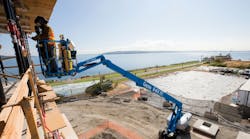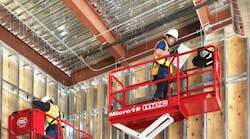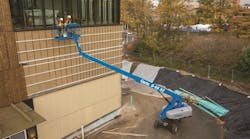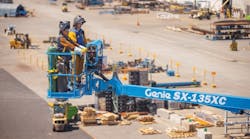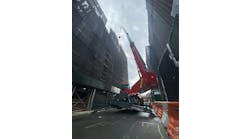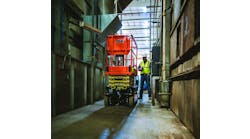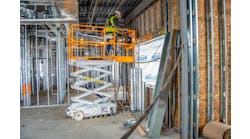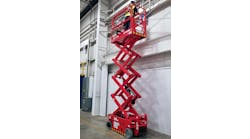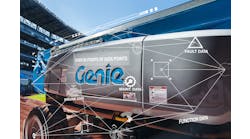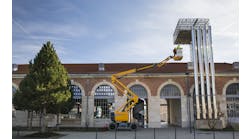RER talks with Matt Fearon, Genie president, Terex AWP, about increasing the productivity of aerial machines, advancements in safety and telematics, the need for infrastructure spending, international aerial growth potential, the future of hybrids and more.
RER: What are some of the new developments technologically in your company’s equipment during the past year?
Fearon: From a machine standpoint, Genie continues to be heavily invested in maximizing the value and rental return on invested capital (rROIC) of our products. Even as global standards are changing how operators do work, we are looking at ways of increasing their productivity. The new Genie Xtra Capacity (XC) booms are designed to provide exceptional capacity consistently across a wide range of products. When customers see the “XC” nomenclature on a Genie machine, they will know that they are getting 660-pound capacity over the maximum range of motion, and 1,000-pound maximum capacity to tackle even the heaviest jobs in less time. The “XC” stamp also signifies that these machines meet the overload requirements of the new ANSI and CSA standards for North America, as well as the EN280 standards in Europe and the AS 1418.10 standards in Australia.
Genie also continues to invest in additional products related to the changing requirements of our global customers and how end-users do work safely and productively. Over the last few years, the industry demand for secondary guarding solutions has accelerated, motivating the standardization of secondary guarding on boom lifts. Genie is committed to supporting efforts to improve workplace safety and productivity on all aerial products, and at its core, the Genie Lift Guard Contact Alarm prototype for scissors was driven by customer feedback and demand from global markets for a secondary guarding solution for scissor lifts and vertical lifts.
The Genie Lift Guard Contact Alarm for scissor lifts and vertical lifts is a switch-based solution that uses activation whiskers mounted on the platform guardrails to sense obstructions. When an activation whisker makes contact with an obstruction, such as a pipe, beam or doorsill, machine motion is stopped. Operators can center the joystick and release the function enable momentarily, which will enable them to then continue to position the platform at reduced function speeds.
Unique to the Genie Lift Guard Contact Alarm system is its visibility to operators, occupants, and ground personnel, providing unmatched clarity regarding the sensing zone. The Genie Lift Guard Contact Alarm tool will supplement a trained operator’s situational awareness and allow operators to make better decisions about how and where they position the platform, without the nuisance trips associated with ambiguous sensing envelopes.
RER: What trends do you see on the horizon with your company’s equipment, and the industry as a whole?Fearon: As we continue to work with our customers on helping them realize the highest rROIC on their machine purchases, we are finding that maximizing their utilization is key. Providing insights into how a machine is utilized and what may keep it from working are instrumental in planning and operating their businesses. Telematics solutions that include information about how a machine is working, as well as what maintenance may keep it from having to come off a job, are a great way to capture and manage this critical data. We are continuing to work directly with our customers to make sure that they have the access to as much of this information as possible, including a link to our machines via a CAN-based control system, as well as what offerings may make them even more efficient in the future.
As our customers continue to become more technologically savvy, we are seeing a growing trend in the use of technology for fleet management. Telematics is a tool that many are starting to use to manage their equipment fleets, from basic location tracking to more sophisticated equipment monitoring. From knowing how equipment is performing or how often a piece is being utilized to where each unit is or when it is ready for maintenance, machine data can provide a lot of insight to a rental business. Today’s technology can help our customers gather, read and understand the information their machines are providing.
In my opinion, we are in the early stages of the adoption of telematics, mobile applications and data-driven fleet management. I expect rental companies around the world to increase their use of these capabilities in the coming years to drive higher rROIC.
There are a few trends that we are seeing that are related to some of the development work we have been doing over the last few years. As emissions standards around the world have become more stringent, engine manufactures are forced to provide solutions that are more costly and complex. To mitigate this, Genie has developed an innovative fuel-electric system for the Genie Z-60/37 FE articulated boom that gives performance of a typical diesel-powered boom in a hybrid machine.
RER: The price of materials is rising with the recent implementation of tariffs from the Trump administration and by other countries in response. How big an impact will this have on manufacturing and on demand for aerial equipment in the marketplace?
Fearon: The recent actions by the Trump administration on tariffs and concerns over trade wars, have had a dampening effect on the growing optimism that the tax changes had created. There was an immediate reaction by U.S. steel mills that significantly raised domestic steel prices. This led to increase costs which have unfortunately been passed on as a steel surcharge.
Certainly, the tax changes have helped offset some of the impact. U.S. companies having a lower tax rate means they’re going to have more money to invest. Rental companies, especially those in acquisition mode, are going to look at whether they can expense their machines rather than depreciate them over a long period of time, and we’re going to see a lot of them saying “hey, this is a unique opportunity.” I don’t think it’s going to radically change what people are doing, but it’s certainly not hurting the overall sentiment.
We can also see the positive effects that talk of infrastructure spending is having. There hasn’t been a huge infusion of money yet, but it seems like every airport I go to is putting up a terminal. There’s no clarity on where the money is coming from, but there are a lot of people saying it looks like it’s going to happen.
All in all, customers are upbeat. They’re getting busier and healthier. And they’re seeing the growth broaden out, so people are feeling good, that’s for sure. The market is strong. This time last year, we were starting to see all the signs, and now they’re clearer. If you look at rental fundamentals -- time utilization and rental rates have come up, the used equipment market is healthy -- those are the core things we’re looking at. Our backlog at the end of December was the highest year-end backlog in Genie’s history, and now 2018 just keeps getting stronger. What’s interesting is that backlog is all over the world too, not just any one market. Certainly, North America drives a lot of it, but Europe is very strong, and Asia is strong.
Right now, we’re still seeing evidence that the replacement cycle will continue to come into our favor in 2018-19. That’s happening, it’s real. So, we’ve got that underlying demand that’s going to be driven just by replacement alone. We need to watch out and always be careful, but when this market runs you’ve got to be able to meet demand. We’ve built our manufacturing system and supply chains to be able to handle the upticks in the market.
We’re optimistic about the next couple of years. We’re not without caution, and from a manufacturer’s standpoint, the issues around tariff and trade are going to have a big impact on steel. The labor shortage, across the board, is also a concern. There aren’t enough truckers to move the equipment around, the supply chain is getting pinched. As everything comes up, there are going to be hurdles, but I view these as the good problems. There’s hard work to do to keep up with the growth, but it’s nothing we’re not used to.
RER: Safety continues to be an important topic in the aerial industry. What are some of the new safety developments on your company’s equipment and do you see any new developments on the horizon?
Fearon: The adoption rate of secondary guarding and sensing technologies in the aerial work platform industry is picking up pace. Bordering industries with shared applications have technologies that we can expect to see adopted by aerial equipment technologies which will improve productivity, workplace safety and rROIC for equipment rental organizations.
For example, demand for secondary guarding solutions on scissor lifts and vertical lifts often comes as a request for a boom solution to be mounted directly to the lift platform. Applications and platform configurations vary greatly between scissor and boom products, requiring secondary guarding solutions of similar function, but different form. The Genie Lift Guard Contact Alarm prototype for scissor lifts/vertical lifts was designed and named to feel familiar to operators who are currently experienced with the Genie Lift Guard Contact Alarm on boom lifts today. We’ve demonstrated the Genie Lift Guard Contact Alarm prototype at various shows throughout North America, Europe and Australia, in addition to jobsite visits with key end users throughout the globe. We continue to evaluate customer feedback throughout the new product and option development process. Launch decisions are based on market demand and the feedback on the Genie Lift Guard Contact Alarm prototype has helped us tailor the design to meet the unique needs of scissor lift and vertical lift applications.
One of the more significant equipment changes coming in the upcoming changes to ANSI A92 and CSA B354 standards will be the addition of platform load sense. This new provision requires many mobile elevated work platforms (MEWPs), formerly known as aerial work platforms, to monitor the weight in the platform and disable functions if the load is above the platform load limit. Essentially, it means that the machine will only allow operators to move and place loads that are within the rated capacity of the platform. With the new platform load sense requirement, MEWPs will be equipped with a sensor, or load sense cell, which has both an audible and visual alarm to alert the operator that the platform has been loaded above the machine’s load limit capacity. On Genie MEWPs, when the platform is overloaded a load sense recovery feature, built into the platform load sense technology, will allow operators to return safely to the ground through limited functionality allowed, from either the platform or ground control station. And, the Genie MEWPs equipped with a load sense are designed with a load sense cell that continuously checks the weight in the platform and limits the operating envelope to match the load chart, all while boasting the ability to do zero load field calibrations.
The international demand for aerial equipment continues to grow as people in different countries and industries become more aware of the benefits of aerial equipment. What might be some of the breakthrough areas in usage of aerials in the foreseeable future?
Fearon: All across the world, jobsites are covering more ground, reaching higher heights, and lifting more material. For example, workers in Las Vegas are breaking ground on a new 225 ft football stadium and aerial operators in Montreal are in the final year of construction on the 3.7-mile long New Champlain Bridge. Jobsites like these need booms that can lift higher capacities, to great heights, and the rental yards providing the boom lifts need ways to monitor their equipment to keep it up and running.
Equipment of all sizes can be found on jobsites such as these, but it’s becoming more common to see the largest booms constantly at work. To get these big jobs done quickly, there’s often multiple workers and plenty of material in every boom basket. On the tallest jobsites these workers are welding and cutting at 180 ft in the air, while many of the infrastructure jobs are using the long outreach and below ground reach of modern booms to complete finishing work on over-water bridges.
As these jobsites expand in size and cover more ground, telematics devices are becoming commonplace items on all types of equipment. Boom lifts are included in this, as this technology helps keep boom lifts up and running, while also making it easier to find the equipment when a task is done and it’s time for the units to be picked-up.
New ANSI standards are expected to be published later this year. Can you summarize the impact the new standards will have on the aerial rental industry?
Fearon: With the pending changes to the ANSI A92 and CSA B354 estimated to go into effect soon, it is important for rental businesses and rental customers to start preparing now for what will be different. From a manufacturer’s perspective, here’s what a rental store needs to know about the new ANSI and CSA standards to be introduced soon:
- You should be prepared for changes to the design of all aerial work platforms — or mobile elevated work platforms (MEWPs) as they will now be called — that are introduced in 2018 and beyond. All aerial lift manufacturers, including Genie, must comply with these new standards.
- The new standards more closely align North American standards (ANSI – United States, CSA – Canada) requirements with current ISO standards. These new standards will dictate how aerial equipment manufacturers serving the North American market address wind ratings, chassis angle and load capacity on MEWPs.
You will begin to see MEWPs introduced that feature load sensors and higher load capacity ratings. Following in the footsteps of EN280, a European standard in effect since 2001, under the new standards aerial equipment in North America will now be equipped with a platform load sensor. Also known as an overload system or load sense system, platform load sense means that the machine will only allow operators to move and place loads that are within the rated capacity of the platform. All MEWPs equipped with load sense will be required to monitor the weight in the platform and disable functions if the load is above the platform load limit.
There are two ways to overload a platform: 1) Too much weight in the basket before it leaves the ground, and 2) adding weight to the basket once it is in the air working.
Common culprits of overloading the platform include:
- Platform capacity is not just calculated by the number and weight of people in the basket. It also includes tools like welding equipment, hammers, buckets, etc., and materials such as pipes, panels, signage, windows, etc.
- Not calculating the weight of jobsite tools or materials accurately. For example, it is easy to put a bucket with a few tools in the basket and not realize that bucket weighs 50 lb or more.
- Touching part of the building or structure you are working near, such as a beam or window ledge, during operation. The weight added from the structure also counts toward the platform’s load capacity.
With the new platform load sensor, or load sense cell, an audible and visual alarm will alert the operator that the platform has been loaded above the machine’s load limit capacity. It is important to educate your employees and customers about what this alarm means and train them on the safe operating procedures necessary to resolve the situation.
From a manufacturer’s perspective, we expect to see boom load capacities go up and more secondary envelopes incorporated into the design of new machines. The development of these new systems will result in more sophisticated control systems and dual capacity load ratings.
In the new standards, MEWPs in North America will also be required to be equipped with a chassis tilt sensor, which measures the angle, or tilt, of the machine’s chassis during operation. With the sensor, when the machine is working on a grade and the chassis isn’t level, an alarm will alert the operator that the angle of the chassis has reached the limit of the manufacturer’s specifications.
This functionality is similar to features currently on most scissor lifts available in the North American market.
To adhere to the wind rating requirements in the new standards, you will see MEWPs categorized as either indoor or outdoor machines. This requirement will have the most effect on small portable products and scissor lifts. While indoor-only aerials may be lighter weight, they will be limited to work in areas not impacted by wind. Machines rated for outdoor use will be designed and manufactured for use in wind as limited by the new standards and as specified on Genie machines. The ramifications of these new requirements mean that you will need to make decisions about the mix of indoor-only versus outdoor-use machines in your fleet.
The current ANSI and CSA standards have, for almost four decades, provided best practices for safe, reliable access to work at height. The last big change to these standards was in the late 1990’s. The new standards will be based on current ISO standard, which will allow North American MEWPs manufacturers, including Genie, to be in better alignment with global markets like Europe, Australia and China, where similar standards are already in place. The move to get North American more closely aligned with a global standard will enable you to more easily trade new and used equipment worldwide.
Any other trends you are seeing or expect to see in the aerial rental industry?
Fearon: Increasingly, hybrid machines are being substituted into jobs where a large diesel or a pure electric machine might have been used in the past. This flexibility is what makes these machines so attractive; each unit can stay out on rent longer to improve the machines ROIC. They also offer the flexibility to be dropped onto an unimproved jobsite before a structure is built, then with the flick of a switch to DC mode, move indoors for finish work.
First and foremost, rental companies need a machine that will do the job for their customers. But, beyond that, they also require a truly reliable, high quality machine. However, this equipment is used hard in the field. Ease of service, knowledgeable support teams and quick parts availability are also critical after the sale.
Honestly, Genie customers find the many of the same features they want in traditional powered equipment is the same that they want in hybrid equipment: They need a tough, reliable, simple to operate and easy to service machine that delivers high value for their money. Hybrid equipment must wrap all of these characteristics into a package that also incorporates the versatility of indoor/outdoor performance.
Technology has advanced hybrid machine design and capabilities. Take the Genie® Z® -60/37 FE hybrid articulated boom as an example. This machine makes it possible for contractors to operate on indoor projects under DC battery power. By switching to hybrid mode, this same boom performs as well as, if not better than diesel-only articulated booms on outdoor projects, while seamlessly charging the batteries via an onboard generator.
The Genie Z-60/37 FE boom doesn’t compromise on performance, regardless of the task. The 48V DC battery pack provides a full day of emissions-free operation indoors on a single battery charge. Its 24-hp diesel engine efficiently powers a generator that delivers automatic battery charging while operating in hybrid mode.
Should the batteries be fully discharged, this hybrid boom can run solely under diesel engine power, while the generator provides a bulk charge to the batteries in about 4 hours. The battery and diesel engine also work together to power through demanding tasks, such as steep terrain, to maximize machine performance.
